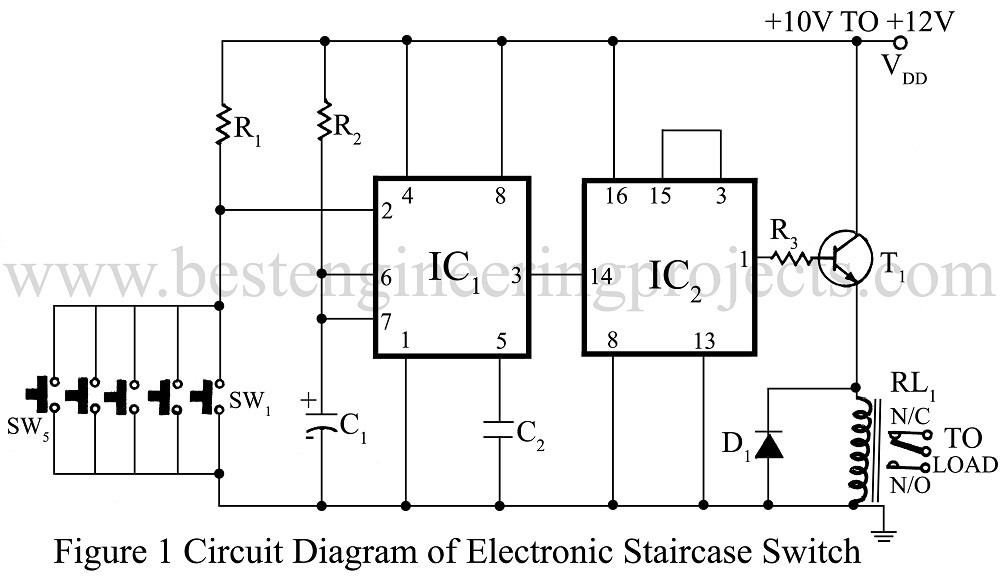If you want to control an electrical appliance from two places then you use the 2-way switch. But to control it from more than two locations (like operating a hotel’s staircase light from individual floors from various locations), the circuit “Staircase Switch” comes to your help. Due to the small size of the staircase switch circuit, it can be installed within a junction box.
Circuit Description of Staircase Switch Circuit
Staircase Switch Circuit utilize IC1 (NE555) as a timer with timing of 0.7 seconds, for this it is configured in monostable mode. When switch SW1 is pressed momentarily, output at pin 3 of IC1 goes high for 0.7 seconds. This clock pulse output from pin 3 of IC1 is fed to the input of IC2 which is actually a decade counter (4022) but is used in staircase switch circuits for division by two.
When the circuit is switched on, Q0 of IC2 goes high. But when switch SW1 is pressed, Q0 goes low and Q1 goes high, thus energizing the relay due to conduction of transistor T1. Q2 of IC2 is conducted to pin 15 of the same IC which reset IC2 when this pin is at a logical high state. When SW1 is pressed while the relay is energized Q1 goes low and Q2 goes high, which reset IC2, turning Q0 to a logically high state and all other outputs (Q1 to Q9) to a logically low state. This cycle is repeated sequentially as push-button SW1 is pressed repeatedly.
Diode D1 has been used in the staircase switch circuit to take care of the back emf generated by the relay during switching. IC1 also takes care of contact debounce as the output of IC1 remains high of 0.7 seconds after the switch has been pressed once. So the bounce of a mechanical switch that lasts for about 20ms has no effects on the working of the staircase switch circuit.
The current consumption of the circuit ‘staircase switch circuit‘, when the relay is inactivated, is about 1omA. This, however, will finally depend upon the rating of the relay used.
PARTS LIST
|
Resistor (all ¼-watt, ± 5% Carbon) |
|
R1, R2 = 10 KΩ R3 = 1.8 KΩ |
|
Capacitors |
|
C1 = 47 µF/25V (electrolytic capacitors) C2 = 0.1 µF (ceramic capacitors) |
|
Semiconductors |
|
IC1 = 555 IC2 = 4022 T1 = SL100 D1 = 1N4001 |
|
Miscellaneous |
|
RL1 = 9V, 100Ω Relay SW1 – SW5….. = Push-To-On Switch |
